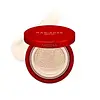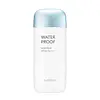Missha Radiance Perfect-Fit Cushion SPF 50+ PA+++ Versus Missha All-Around Safe Block Waterproof Sun Milk SPF 50+
What's inside
What's inside
 Key Ingredients
Key Ingredients

 Benefits
Benefits

 Concerns
Concerns

 Ingredients Side-by-side
Ingredients Side-by-side

Water
Skin ConditioningCI 77891
Cosmetic ColorantCyclopentasiloxane
EmollientEthylhexyl Methoxycinnamate
UV AbsorberDimethicone
EmollientPhenyl Trimethicone
Skin ConditioningEthylhexyl Salicylate
UV AbsorberButylene Glycol
HumectantLauryl PEG-10 Tris(Trimethylsiloxy)Silylethyl Dimethicone
EmulsifyingNiacinamide
Smoothing1,2-Hexanediol
Skin ConditioningCI 77492
Cosmetic ColorantPEG-9 Polydimethylsiloxyethyl Dimethicone
EmulsifyingGlycerin
HumectantCentella Asiatica Extract
CleansingChamomilla Recutita Extract
Skin ConditioningMacadamia Ternifolia Seed Oil
EmollientOlea Europaea Fruit Oil
MaskingSimmondsia Chinensis Seed Oil
EmollientVitis Vinifera Seed Oil
EmollientButylene Glycol Dicaprylate/Dicaprate
EmollientCetyl PEG/PPG-10/1 Dimethicone
EmulsifyingMethyl Hydrogenated Rosinate
PerfumingIsododecane
EmollientMagnesium Sulfate
Disteardimonium Hectorite
StabilisingAcrylates/Polytrimethylsiloxymethacrylate Copolymer
Skin ConditioningGlyceryl Caprylate
EmollientPolypropylsilsesquioxane
Vinyl Dimethicone/Lauryl Dimethicone Crosspolymer
Aluminum Hydroxide
EmollientStearic Acid
CleansingAlumina
AbrasiveTriethoxycaprylylsilane
Ethylhexylglycerin
Skin ConditioningAdenosine
Skin ConditioningHydrogenated Castor Oil Isostearate
Skin ConditioningPEG-10 Dimethicone
Skin ConditioningSilica
AbrasivePolymethyl Methacrylate
Pullulan
Caprylic/Capric Triglyceride
MaskingHydrogenated Lecithin
EmulsifyingSucrose Palmitate
EmollientAcrylates/Dimethicone Copolymer
Skin ConditioningCeramide NP
Skin ConditioningSodium Stearoyl Glutamate
CleansingDisodium EDTA
Parfum
MaskingCI 77491
Cosmetic ColorantCI 77499
Cosmetic ColorantWater, CI 77891, Cyclopentasiloxane, Ethylhexyl Methoxycinnamate, Dimethicone, Phenyl Trimethicone, Ethylhexyl Salicylate, Butylene Glycol, Lauryl PEG-10 Tris(Trimethylsiloxy)Silylethyl Dimethicone, Niacinamide, 1,2-Hexanediol, CI 77492, PEG-9 Polydimethylsiloxyethyl Dimethicone, Glycerin, Centella Asiatica Extract, Chamomilla Recutita Extract, Macadamia Ternifolia Seed Oil, Olea Europaea Fruit Oil, Simmondsia Chinensis Seed Oil, Vitis Vinifera Seed Oil, Butylene Glycol Dicaprylate/Dicaprate, Cetyl PEG/PPG-10/1 Dimethicone, Methyl Hydrogenated Rosinate, Isododecane, Magnesium Sulfate, Disteardimonium Hectorite, Acrylates/Polytrimethylsiloxymethacrylate Copolymer, Glyceryl Caprylate, Polypropylsilsesquioxane, Vinyl Dimethicone/Lauryl Dimethicone Crosspolymer, Aluminum Hydroxide, Stearic Acid, Alumina, Triethoxycaprylylsilane, Ethylhexylglycerin, Adenosine, Hydrogenated Castor Oil Isostearate, PEG-10 Dimethicone, Silica, Polymethyl Methacrylate, Pullulan, Caprylic/Capric Triglyceride, Hydrogenated Lecithin, Sucrose Palmitate, Acrylates/Dimethicone Copolymer, Ceramide NP, Sodium Stearoyl Glutamate, Disodium EDTA, Parfum, CI 77491, CI 77499
Hydrolyzed Chestnut Extract
Skin ProtectingCyclopentasiloxane
EmollientHomosalate
Skin ConditioningSilica
AbrasiveEthylhexyl Salicylate
UV AbsorberTitanium Dioxide
Cosmetic ColorantLauryl PEG-10 Tris(Trimethylsiloxy)Silylethyl Dimethicone
EmulsifyingDiethylamino Hydroxybenzoyl Hexyl Benzoate
UV FilterGlycerin
HumectantC12-15 Alkyl Benzoate
AntimicrobialAlcohol Denat.
AntimicrobialBis-Ethylhexyloxyphenol Methoxyphenyl Triazine
Skin ConditioningIsopropyl Palmitate
EmollientAloe Barbadensis Leaf Extract
EmollientPsidium Guajava Leaf Extract
AstringentVerbena Officinalis Leaf Extract
MaskingSmilax China Bark Extract
Skin ConditioningUlmus Davidiana Root Extract
Skin ConditioningEucalyptus Alba Leaf Extract
Skin ConditioningWater
Skin ConditioningButylene Glycol
HumectantDimethicone
EmollientMagnesium Sulfate
Aluminum Hydroxide
EmollientStearic Acid
CleansingQuaternium-18 Bentonite
PEG-10 Dimethicone
Skin ConditioningDimethicone/Vinyl Dimethicone Crosspolymer
Skin ConditioningTriethoxycaprylylsilane
Acrylates/Dimethicone Copolymer
Skin ConditioningSilica Dimethyl Silylate
EmollientSodium Benzoate
MaskingTocopheryl Acetate
AntioxidantPotassium Sorbate
PreservativeVp/Hexadecene Copolymer
Vp/Va Copolymer
Disodium EDTA
Phenoxyethanol
PreservativeLinalool
PerfumingBenzyl Salicylate
PerfumingLimonene
PerfumingGeraniol
PerfumingHexyl Cinnamal
PerfumingHydrolyzed Chestnut Extract, Cyclopentasiloxane, Homosalate, Silica, Ethylhexyl Salicylate, Titanium Dioxide, Lauryl PEG-10 Tris(Trimethylsiloxy)Silylethyl Dimethicone, Diethylamino Hydroxybenzoyl Hexyl Benzoate, Glycerin, C12-15 Alkyl Benzoate, Alcohol Denat., Bis-Ethylhexyloxyphenol Methoxyphenyl Triazine, Isopropyl Palmitate, Aloe Barbadensis Leaf Extract, Psidium Guajava Leaf Extract, Verbena Officinalis Leaf Extract, Smilax China Bark Extract, Ulmus Davidiana Root Extract, Eucalyptus Alba Leaf Extract, Water, Butylene Glycol, Dimethicone, Magnesium Sulfate, Aluminum Hydroxide, Stearic Acid, Quaternium-18 Bentonite, PEG-10 Dimethicone, Dimethicone/Vinyl Dimethicone Crosspolymer, Triethoxycaprylylsilane, Acrylates/Dimethicone Copolymer, Silica Dimethyl Silylate, Sodium Benzoate, Tocopheryl Acetate, Potassium Sorbate, Vp/Hexadecene Copolymer, Vp/Va Copolymer, Disodium EDTA, Phenoxyethanol, Linalool, Benzyl Salicylate, Limonene, Geraniol, Hexyl Cinnamal
 Reviews
Reviews

Ingredients Explained
These ingredients are found in both products.
Ingredients higher up in an ingredient list are typically present in a larger amount.
This polymer has film-forming properties and helps leave behind a soft film on the skin with oxygen permeability.
That's why you'll most likely find this in sunscreen formulations.
Aluminum Hydroxide is a form of aluminum. It can be naturally found in nature as the mineral gibbsite. In cosmetics, Aluminum Hydroxide is used as a colorant, pH adjuster, and absorbent.
As a colorant, Aluminum Hydroxide may add opacity, or reduce the transparency. Aluminum hydroxide is contains both basic and acidic properties.
According to manufacturers, this ingredient is an emollient and humectant. This means it helps hydrate the skin.
In medicine, this ingredient is used to help relieve heartburn and help heal ulcers.
There is currently no credible scientific evidence linking aluminum hydroxide in cosmetics to increased cancer risk.
Major health organizations allow the use of aluminum hydroxide in personal care products and have not flagged it as a carcinogenic risk at typical usage levels.
Learn more about Aluminum HydroxideButylene Glycol (or BG) is used within cosmetic products for a few different reasons:
Overall, Butylene Glycol is a safe and well-rounded ingredient that works well with other ingredients.
Though this ingredient works well with most skin types, some people with sensitive skin may experience a reaction such as allergic rashes, closed comedones, or itchiness.
Learn more about Butylene GlycolCyclopentasiloxane, or D5, is a silicone used to improve texture of products and trap moisture.
D5 is considered lightweight and volatile. Volatile means it evaporates quickly after application. Once evaporated, D5 leaves a thin barrier that helps keep skin hydrated.
It is also an emollient. Emollients help soften the skin and prevent water loss. Silicones create a silky texture in products. D5 helps other ingredients become more spreadable.
Studies show D5 is safe to use in skincare products. We recommend speaking with a skincare professional if you have concerns.
Learn more about CyclopentasiloxaneDimethicone is a type of synthetic silicone created from natural materials such as quartz.
What it does:
Dimethicone comes in different viscosities:
Depending on the viscosity, dimethicone has different properties.
Ingredients lists don't always show which type is used, so we recommend reaching out to the brand if you have questions about the viscosity.
This ingredient is unlikely to cause irritation because it does not get absorbed into skin. However, people with silicone allergies should be careful about using this ingredient.
Note: Dimethicone may contribute to pilling. This is because it is not oil or water soluble, so pilling may occur when layered with products. When mixed with heavy oils in a formula, the outcome is also quite greasy.
Learn more about DimethiconeDisodium EDTA plays a role in making products more stable by aiding other preservatives.
It is a chelating agent, meaning it neutralizes metal ions that may be found in a product.
Disodium EDTA is a salt of edetic acid and is found to be safe in cosmetic ingredients.
Learn more about Disodium EDTAEthylhexyl Salicylate is an organic compound used to block UV rays. It primarily absorbs UVB rays but offers a small amount of UVA protection as well.
Commonly found in sunscreens, Ethylhexyl Salicylate is created from salicylic acid and 2-ethylhexanol. You might know salicylic acid as the effective acne fighter ingredient and BHA.
The ethylhexanol in this ingredient is a fatty alcohol and helps hydrate your skin, similar to oils. It is an emollient, which means it traps moisture into the skin.
According to manufacturers, Ethylhexyl Salicylate absorbs UV wavelength of 295-315 nm, with a peak absorption at 307-310 nm. UVA rays are linked to long term skin damage, such as hyperpigmentation. UVB rays emit more energy and are capable of damaging our DNA. UVB rays cause sunburn.
Learn more about Ethylhexyl SalicylateGlycerin is already naturally found in your skin. It helps moisturize and protect your skin.
A study from 2016 found glycerin to be more effective as a humectant than AHAs and hyaluronic acid.
As a humectant, it helps the skin stay hydrated by pulling moisture to your skin. The low molecular weight of glycerin allows it to pull moisture into the deeper layers of your skin.
Hydrated skin improves your skin barrier; Your skin barrier helps protect against irritants and bacteria.
Glycerin has also been found to have antimicrobial and antiviral properties. Due to these properties, glycerin is often used in wound and burn treatments.
In cosmetics, glycerin is usually derived from plants such as soybean or palm. However, it can also be sourced from animals, such as tallow or animal fat.
This ingredient is organic, colorless, odorless, and non-toxic.
Glycerin is the name for this ingredient in American English. British English uses Glycerol/Glycerine.
Learn more about GlycerinLauryl PEG-10 Tris(Trimethylsiloxy)Silylethyl Dimethicone is a type of silicone.
Magnesium Sulfate is a salt. More specifically, it is an epsom salt, or the bath salt used to help relieve muscle aches.
Despite having ‘sulfate’ in the name, it isn’t a surfactant or cleansing agent like sodium lauryl sulfate. Unlike those sulfates, magnesium sulfate doesn’t have the same cleansing or foaming properties (it's simply a type of salt).
In cosmetics, Magnesium Sulfate is used to thicken a product or help dilute other solids. It is a non-reactive and non-irritating ingredient.
One study shows magnesium deficiency may lead to inflammation of the skin. Applying magnesium topically may help reduce inflammation.
You can find this ingredient in sea water or mineral deposits.
Learn more about Magnesium SulfatePeg-10 Dimethicone is silicone with conditioner and emulsifier properties. It mostly acts as an emollient in skincare and and humectant in haircare.
According to the manufacturer, acidic formulations decrease the stability of this ingredient. It works best in neutral or near neutral formulations.
Silica, also known as silicon dioxide, is a naturally occurring mineral. It is used as a fine, spherical, and porous powder in cosmetics.
Though it has exfoliant properties, the function of silica varies depending on the product.
The unique structure of silica enhances the spreadability and adds smoothness, making it a great texture enhancer.
It is also used as an active carrier, emulsifier, and mattifier due to its ability to absorb excess oil.
In some products, tiny microneedles called spicules are made from silica or hydrolyzed sponge. When you rub them in, they lightly polish away dead skin layers and enhance the penetration of active ingredients.
Learn more about SilicaStearic Acid is a fatty acid. It is an emollient, emulsifier, and texture enhancer.
As an emollient, stearic acid helps soften skin. It aids the skin's protective barrier by preventing water loss. It also provides a gentle cleansing effect without stripping away natural oils.
Stearic acid may also be used to enhance the texture of products. It can add volume and stabilize ingredients such as water and oil. This can help water and oil ingredients from separating.
Sources of stearic acid include animal or vegetable fats/oils such as coconut or shea. It can be naturally found in butter, cocoa butter, shea butter, vegetable fats, and animal tallow.
This ingredient may not be Malassezia folliculitis, or fungal-acne safe.
Learn more about Stearic AcidTriethoxycaprylylsilane is a silicone used to bind and stabilize ingredients.
As an emulsifier, it helps prevent ingredients from separating. This can help elongate the shelf life of products.
Triethoxycaprylylsilane is often used to coat mineral sunscreens ingredients to help give a better feel. It also helps reduce oxidative stress in sunscreens.
Learn more about TriethoxycaprylylsilaneWater. It's the most common cosmetic ingredient of all. You'll usually see it at the top of ingredient lists, meaning that it makes up the largest part of the product.
So why is it so popular? Water most often acts as a solvent - this means that it helps dissolve other ingredients into the formulation.
You'll also recognize water as that liquid we all need to stay alive. If you see this, drink a glass of water. Stay hydrated!
Learn more about Water